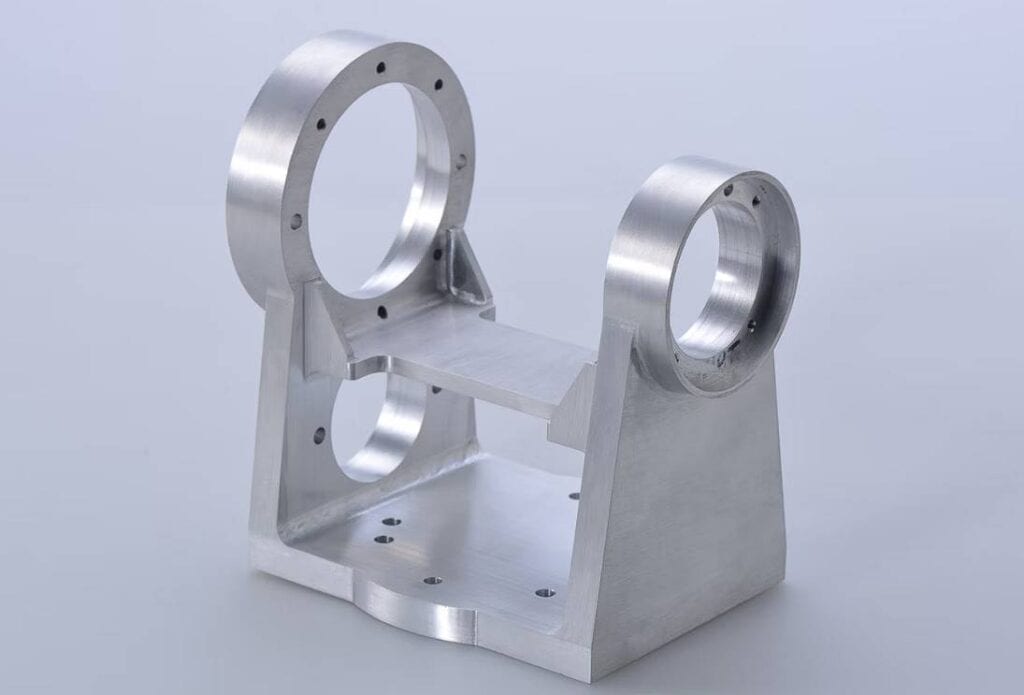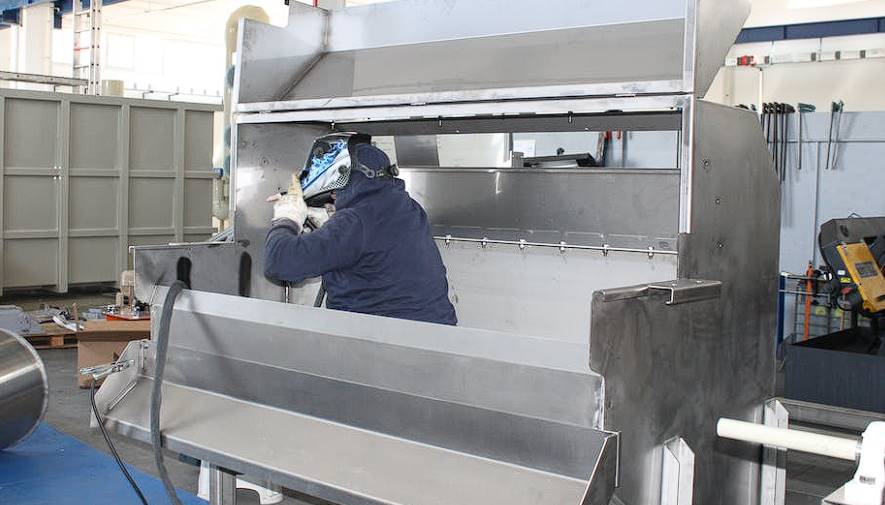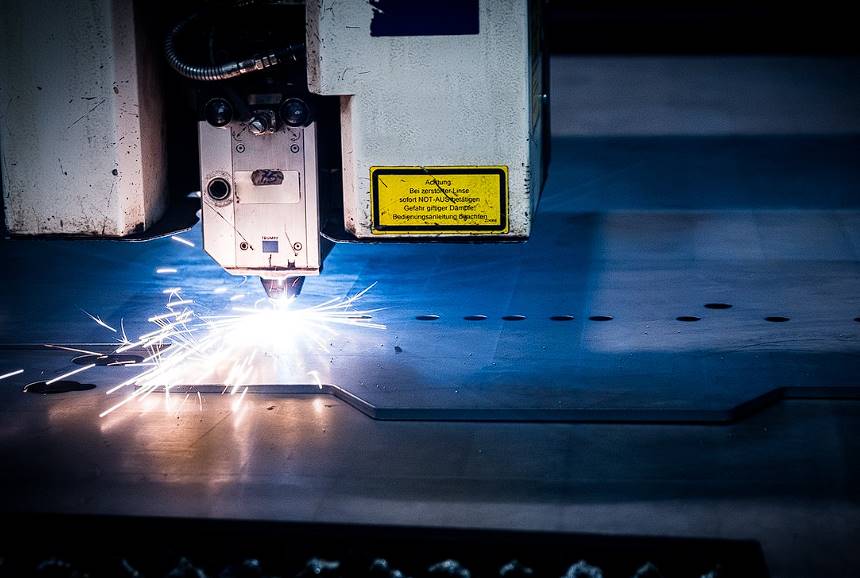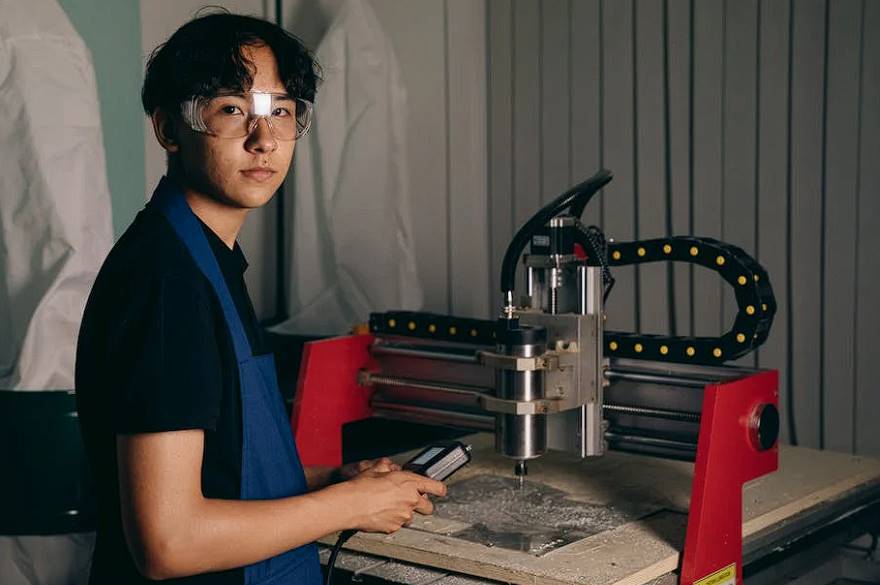Within the complex realm of metal fabrication, the press brake is a fundamental component that embodies precision and versatility throughout the industry. Flat sheets can be transformed into specified shapes and angles with the help of this robust equipment, which is vital for bending sheet and plate metal. It combines force and elegance to accomplish this transformation.
On the other hand, what lies beneath its sturdy exterior? Anyone involved in metalworking needs to have a solid understanding of the structure of a press brake. This includes engineers, operators, and business owners considering investment pieces of machinery.
In the following blog post, we will go deeply into the anatomy of a press brake, examining each component that plays a role in the operation of the press brake. We will disassemble the machine piece by piece, beginning with the bed and ram and moving on to the background and tooling. Our goal is to shed light on how these components interact with one another to produce exact bends.
Suppose you are a seasoned professional in the manufacturing field or fascinated by the mechanics of metal shaping. In that case, you are invited to join us as we uncover the complexity of the structure of the press brake. This investigation will not only help you gain a better knowledge of how press brakes function, but it will also shed light on the technological breakthroughs that are still being made in the field of metal production.
Main Components Of A Press Brake
Press brakes are fundamental in metal fabrication, allowing operators to bend sheet metal into various shapes and forms. These machines range from manual to fully automated systems designed to meet specific production needs. Understanding the main components of a press brake is essential for anyone involved in metalworking. Here's an overview based on the information gathered from the provided sources:

The Bed:
The bed is the base of the press brake, serving as the foundation upon which the metal sheet rests during the bending process. It's typically made from heavy-duty steel to withstand the pressure exerted during bending.
The Ram (Or Beam):
The ram moves vertically to apply force to the metal sheet against the die on the bed. This movement can be powered by mechanical, hydraulic, pneumatic, or electric means, depending on the type of press brake.
The Backgauge:
The back gauge is a critical component for precision in bending operations. It positions the workpiece accurately by moving it to the correct location before the bend is made. Modern press brakes feature CNC-controlled back gauges that can move along multiple axes for complex bending tasks.
The Die And Punch (Tooling):
Tooling shapes the metal during the bending process. The punch is attached to the ram and presses the metal into the die, which is mounted on the bed. Various types of dies and punches are designed for different bending operations, allowing for a wide range of shapes and angles to be achieved.
Hydraulic System:
Hydraulic press brakes use a hydraulic system to move the ram. This system consists of a hydraulic pump, valves, and cylinders, providing the force needed for bending. Hydraulic systems are known for their power and ability to handle heavy-duty bending operations.
CNC Controller:
On CNC (Computer Numerical Control) press brakes, a CNC controller programs and controls the bending process, including the movement of the back gauge and ram. This allows for high precision and repeatability in bends.
Safety Features:
Modern press brakes are equipped with various safety features to protect the operator. These may include light curtains, laser guards, and emergency stop buttons. Safety systems ensure the machine stops immediately if a hand or other object is detected too close to the bending area.
Electrical Components:
Electrical components, such as motors and control systems, power the press brake and its movements. High-quality electrical components ensure the reliability and efficiency of the machine.
Structural Integrity:
The overall structure of a press brake is designed for durability and rigidity. The frame is typically made of welded steel, which is stress-relieved to prevent deformation over time. This ensures consistent bending accuracy.
Operational Features
Press brakes are indispensable tools in the metal fabrication industry, enabling the transformation of sheet metal into various forms and structures through precise bending. The operational features of press brakes have evolved significantly, incorporating advanced technologies to meet the diverse needs of modern manufacturing. Here's an overview of the critical operational features based on the information from the provided sources:
Types Of Press Brakes:
Pneumatic Press Brakes: Best suited for light-duty tasks involving the thinnest gauge materials.
Mechanical Press Brakes: Utilise a flywheel-driven crankshaft to apply force, offering robust performance for various materials.
Hydraulic Press Brakes: Employ hydraulics to move the ram or bed up and down, providing robust and precise pressure application.
Electric Press Brakes: Use ball screw or belt-driven mechanisms to move the ram, offering energy efficiency and precision.
CNC Technology:
Many modern press brakes have CNC (Computer Numerical Control) systems, allowing for exact bends based on pre-programmed instructions. CNC technology enhances the machine's flexibility, enabling it to perform complex bending operations with high accuracy and repeatability.
Hydraulic System:
The hydraulic system is a cornerstone of many press brakes, ensuring stable and reliable operation. It allows for smooth movement of the ram, precise control over bending force, and the ability to handle a wide range of material thicknesses.
Safety Features:
Safety is paramount in the operation of press brakes. Modern machines include various safety features such as light curtains, laser guards, and emergency stop buttons to protect operators from accidents.
Back Gauge System:
The back gauge system is crucial for achieving precise bends. It positions the workpiece accurately before each bend, and with CNC control, it can be adjusted automatically for complex bending sequences.
Tooling:
Press brake tooling, including punches and dies, is designed to accommodate various bending operations. Quick-change and segmented tooling systems allow for flexibility in handling different jobs without extensive downtime.
Bending Accuracy And Efficiency:
Advanced press brakes feature technologies like dynamic crowning and angle measurement systems to ensure bending accuracy across the length of the machine. These features compensate for material inconsistencies and machine deflections, resulting in uniform bends.
Energy Efficiency:
Energy efficiency is a growing concern in manufacturing. Electric press brakes and those with energy-saving drives reduce power consumption, lowering operational costs and environmental impact.
Automation Capabilities:
Automation is increasingly integrated into press brake operations. From robotic loading and unloading to fully automated bending cells, these features increase productivity, reduce labour costs, and improve safety.
Flexibility And Customisation:
Press brakes are designed to be flexible and customisable, catering to the specific needs of different fabrication projects. From in-house forming capabilities like punching and hemming to complex forming and prototype development, press brakes adapt to various manufacturing requirements.
Advanced Features And Accessories
Press brakes, essential in the metal fabrication industry for bending sheet metal, have evolved significantly with advancements in technology and engineering. These advancements have led to various advanced features and accessories that enhance efficiency, precision, and safety. Here's an overview of some of the most notable advancements based on the information from the provided sources:
Robotic Automation:
Robotic press brakes represent a leap forward in automation for the metal fabrication industry. These systems combine traditional press brakes with advanced 6-axis or 7-axis robots, providing unmanned and stable sheet metal bending processes. This integration improves cost-effectiveness and ROI, ensures high-level consistency of workpieces, reduces labour costs and intensity, and achieves safe production results.
CNC Crowning:
CNC crowning systems automatically adjust the press brake bed to compensate for deflection during bending. This feature is crucial for maintaining bending accuracy across the press brake's length, ensuring that the angle of the bend is consistent from one end to the other.
Multi-Axis Backgauges:
Modern press brakes feature multi-axis back gauges controlled by CNC systems. These back gauges can move in several directions, allowing for complex part handling and precise workpiece positioning before bending. This capability is essential for achieving high precision in complex bending tasks.
Tooling Innovations:
Advancements in tooling, such as quick-change systems and segmented tooling, allow for rapid setup changes and flexibility in handling various bending operations. Specialised tooling, including hemming tools and Rolla-V dies, enables fabricators to perform specific challenging or impossible bends with traditional tooling.
Safety Enhancements:
Modern press brakes have significantly enhanced safety features. Light curtains, laser guards, and safety-rated control systems help protect operators from injury. These systems ensure the machine stops immediately if a hand or other object is detected too close to the bending area.

Energy Efficiency:
Energy-efficient drives and motors have been developed to reduce the power consumption of press brakes. These systems lower operational costs and contribute to a more sustainable manufacturing process.
Material Handling Accessories:
Additional accessories, such as sheet followers and part collection systems, can be integrated with press brakes to automate the bending process further. These systems support the workpiece during bending and collect finished parts, reducing manual labour and improving workflow efficiency.
Intelligent Control Systems:
Advanced control systems offer intuitive programming and real-time monitoring of the bending process. These systems can store multiple bending programs, adjust parameters on the fly, and provide feedback to operators, ensuring optimal performance and reducing the likelihood of errors.
Customisation Options:
Press brakes can be customised with various features and accessories to meet specific production needs. From special tooling and gauging options to custom software and automation solutions, manufacturers offer a wide range of customisation to enhance the capabilities of their machines.
Conclusion
The press brake is crucial in the metal fabrication industry, allowing operators to transform flat sheets into specific shapes and angles. It combines force and elegance to achieve this transformation. The press brake's structure is essential for anyone involved in metalworking, including engineers, operators, and business owners. The main components of a press brake include the bed, ram, back gauge, die, punch, hydraulic system, CNC controller, safety features, electrical components, and structural integrity.
The bed is the base of the press brake, typically made from heavy-duty steel. The ram moves vertically to apply force to the metal sheet against the die on the bed, powered by mechanical, hydraulic, pneumatic, or electric means. The back gauge is critical for precision in bending operations and positioning the workpiece accurately. Modern press brakes feature CNC-controlled back gauges for complex bending tasks.
The die and punch shape the metal during the bending process, with various types designed for different bending operations. Hydraulic systems provide the force needed for bending, while CNC controllers program and control the bending process. Safety features, such as light curtains, laser guards, and emergency stop buttons, protect the operator. High-quality electrical components power the press brake and its movements.
Press brakes are essential in the metal fabrication industry, transforming sheet metal into various forms and structures through precise bending. They have evolved significantly with advanced technologies to meet modern manufacturing needs. Vital operational features include pneumatic press brakes, mechanical press brakes, hydraulic press brakes, and electric press brakes. Many modern press brakes are equipped with CNC technology, which enhances the machine's flexibility and precision.
Safety features include light curtains, laser guards, and emergency stop buttons to protect operators from accidents. The back gauge system is crucial for precise bends, and with CNC control, it can be adjusted automatically for complex sequences. Press brake tooling, including punches and dies, accommodates various bending operations.
Advancements in technology and engineering have led to the development of advanced features and accessories designed to enhance efficiency, precision, and safety. Robotic automation, CNC crowning, multi-axis back gauges, tooling innovations, safety enhancements, energy efficiency, material handling accessories, and intelligent control systems have all contributed to the evolution of press brakes.
Customisation options include special tooling and gauging, custom software, and automation solutions. These features cater to the specific needs of different fabrication projects and contribute to a more sustainable manufacturing process. Overall, press brakes have evolved significantly to meet the diverse needs of modern manufacturing.
Content Summary
- The press brake is a cornerstone of metal fabrication, embodying precision and versatility.
- It transforms flat sheets into specified shapes and angles, combining force with finesse.
- Understanding the structure of a press brake is crucial for those involved in metalworking.
- The blog delves into the anatomy of a press brake, examining each operational component.
- The blog explores how these parts interact, from the bed and RAM to the background and tooling.
- The bed is a foundation made from heavy-duty steel to withstand bending pressure.
- The ram applies force to the metal sheet against the die, powered by various means.
- The back gauge positions the workpiece accurately, featuring CNC control for precision.
- Tooling shapes the metal during bending, with various types for different operations.
- Hydraulic systems provide the force needed for bending and are known for their power and reliability.
- CNC controllers program and control the bending process, enhancing precision and repeatability.
- Safety features, including light curtains and emergency stop buttons, protect operators from accidents.
- Electrical components power the press brake and its movements, ensuring reliability and efficiency.
- The structure of a press brake is designed for durability, with a frame made of welded steel.
- Operational features of press brakes have evolved, incorporating advanced technologies.
- Types of press brakes include pneumatic, mechanical, hydraulic, and electric, each with unique benefits.
- CNC technology allows for precise bends based on pre-programmed instructions.
- The hydraulic system ensures stable operation and can handle various material thicknesses.
- Safety features in modern machines include various mechanisms to protect operators.
- The back gauge system is crucial for achieving precise bends, with CNC control for complex tasks.
- Tooling innovations, like quick-change systems, allow for flexibility in bending operations.
- Advanced press brakes feature technologies for bending accuracy and efficiency.
- Energy efficiency is a growing concern, with developments in drives and motors to reduce consumption.
- Automation capabilities increase productivity, reduce labour costs, and improve safety.
- Press brakes are designed to be flexible and customisable, catering to specific fabrication projects.
- Robotic automation represents a leap forward, combining traditional press brakes with advanced robots.
- CNC crowning systems adjust the press brake bed to compensate for deflection during bending.
- Multi-axis back gauges controlled by CNC systems allow for precise workpiece positioning.
- Tooling innovations enable fabricators to perform specific bends that were previously challenging.
- Safety features have been significantly enhanced to protect operators from injury.
- Energy-efficient drives and motors reduce power consumption and operational costs.
- Material handling accessories, like sheet followers, further automate the bending process.
- Intelligent control systems offer intuitive programming and real-time monitoring.
- Customisation options allow press brakes to be tailored to meet specific production needs.
- The evolution of press brakes reflects the increasing demands for precision in metal fabrication.
- Understanding the advanced features and accessories of press brakes is crucial for maximising efficiency.
- The blog aims to comprehensively understand press brake structure and operation.
- It highlights the importance of each component in achieving precise and consistent bends.
- The exploration of press brakes reveals the technological advancements in metal production.
- Press brakes are vital in transforming sheet metal into various forms and structures.
- The blog invites readers to explore the complex structure of press brakes.
- It aims to show how press brakes function and the ongoing technological breakthroughs.
- The detailed examination of press brake components enhances manufacturing professionals' knowledge.
- The overview of operational features emphasises the evolution of press brakes in modern manufacturing.
- Advanced features and accessories of press brakes are explored to highlight efficiency and safety enhancements.
- The blog is an informative guide for engineers, operators, and business owners involved in metalworking.
- It encourages a deeper understanding of press brakes and their critical role in metal fabrication.
- The structure and operation of press brakes are vital to achieving high-quality metal fabrication results.
- The blog provides valuable insights into selecting and utilising press breaks for specific projects.
- Understanding the advanced features and accessories of press brakes is essential for staying ahead in the industry.
Frequently Asked Questions
The main components include the bed (the base of the machine), the ram (or beam) that applies force, the back gauge for positioning the workpiece, and the tooling (die and punch) that shapes the metal.
The bed serves as the foundation for the press brake, supporting the metal sheet during the bending process. It's typically made from heavy-duty steel to withstand the pressure exerted during bending.
The ram moves vertically to apply force to the metal sheet against the die on the bed. This movement can be powered by mechanical, hydraulic, pneumatic, or electric means.
The back gauge positions the workpiece accurately by moving it to the correct location before the bend. Modern press brakes feature CNC-controlled back gauges for complex bending tasks.
Tooling, consisting of the die and punch, is crucial for shaping the metal during the bending process. Various types of dies and punches are designed for different bending operations.





















